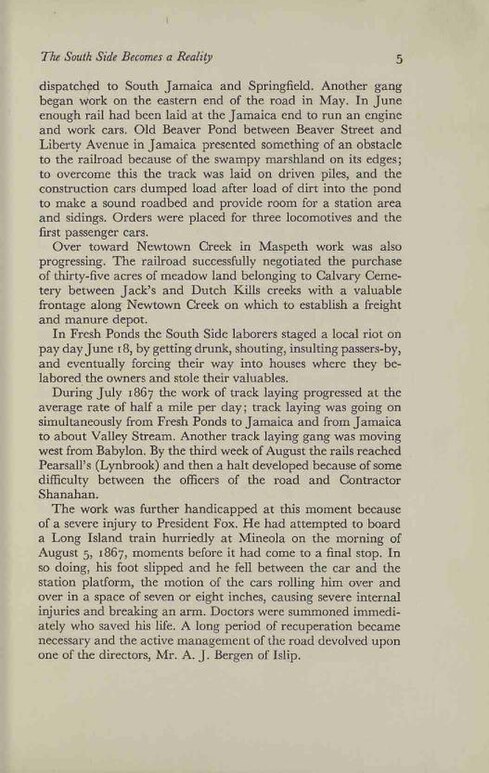dispatched to South Jamaica and Springfield. Another gang began Work on the eastern end of the road in May. In June enough rail had been laid at the Jamaica end to run an engine and work cars. Old Beaver Pond between Beaver Street and Liberty Avenue in Jamaica presented something of an obstacle to the railroad because of the swampy marshland on its edges; to overcome this the track was laid on driven piles, and the construction cars dumped load after load of dirt into the pond to make a sound roadbed and provide room for a station area and sidings. Orders were placed for three locomotives and the first passenger cars.
Over toward Newtown Creek in Maspeth work was also progressing. The railroad successfully negotiated the purchase of thirty-five acres of meadow land belonging to Calvary Cemetery between Jack's and Dutch Kills creeks with a valuable frontage along Newtown Creek on which to establish a freight and manure depot.
In Fresh Ponds the South Side laborers staged a local riot on pay day June 18, by getting drunk, shouting, insulting passers-by, and eventually forcing their way into houses where they belabored the owners and stole their valuables.
During July 1867 the work of track laying progressed at the average rate of half a mile per day; track laying was going on simultaneously from Fresh Ponds to Jamaica and from Jamaica to about Valley Stream. Another track laying gang was moving west from Babylon. By the third week of August the rails reached Pearsall's (Lynbrook) and then a halt developed because of some difficulty between the officers of the road and Contractor Shanahan.
The work was further handicapped at this moment because of a severe injury to President Fox. He had attempted to board a Long Island train hurriedly at Mineola on the morning of August 5, 1867, moments before it had come to a final stop. In so doing, his foot slipped and he fell between the car and the station platform, the motion of the cars rolling him over and over in a space of seven or eight inches, causing severe internal injuries and breaking an arm. Doctors were summoned immediately who saved his life. A long period of recuperation became necessary and the active management of the road devolved upon one of the directors, Mr. A. J. Bergen of Islip.
